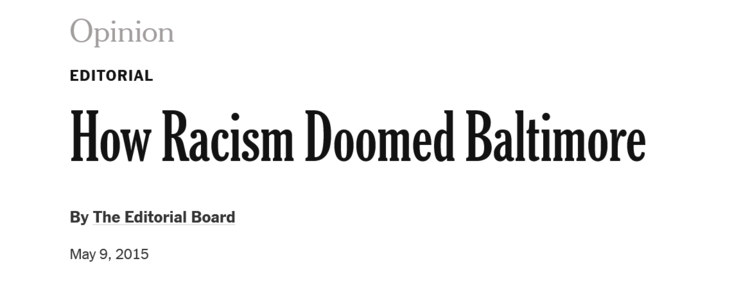A few days ago I wrote about “Progressives’ Increasing Infatuation with Antiquarianism:”
There’s been a real upsurge in antiquarianism among liberals / progressives who are embarrassed to admit that they’ve held the whip hand on race for the last half century. So we see all these articles these days dredging up obscure 20th Century history to generate (contradictory, but who is checking?) rationalizations for why, say, Baltimore or Ferguson or wherever has high rates of black criminality, although they seldom seem to come up with counter-examples of areas where enlightened policies led to low rates of black criminality.
Today, the New York Times Editorial Board illustrates my theme for me at great length:
How Racism Doomed Baltimore
By THE EDITORIAL BOARD MAY 9, 2015
The Baltimore riots threw a spotlight on the poverty and isolation of the African-American community where the unrest began last month. The problems were underscored on Friday when the Justice Department, in response to Mayor Stephanie Rawlings-Blake’s request, started an investigation of the Police Department, which has an egregious history of brutality and misconduct.
Other cities are plagued by the same difficulties, but they have proved especially intractable in Baltimore. A new study from Harvard
I.e., Professor Chetty’s dubious data trove.
offers evidence that Baltimore is perhaps the worst large city in the country when measured by a child’s chances of escaping poverty. …
As shocking as they are, these facts make perfect sense in the context of the century-long assault that Baltimore’s blacks have endured at the hands of local, state and federal policy makers, all of whom worked to quarantine black residents in ghettos, making it difficult even for people of means to move into integrated areas that offered better jobs, schools and lives for their children. This happened in cities all over the country, but the segregationist impulse in Maryland generally was particularly virulent and well-documented in Baltimore, which is now 63 percent black.
Americans might think of Maryland as a Northern state, but it was distinctly Southern in its attitudes toward race.
Those evil Southerners …
Of course, an undeniably Southern city, Atlanta, has been a magnet for well-educated blacks for several decades now, but that’s not the point, the point is that Baltimore is kind of Southern, and we all know everything has to be the fault of white Southerners.
In the first decade of the 20th century
I.e., over 100 years ago
, for example, the Legislature approved amendments to the State Constitution to deny the vote to black citizens. Voters rejected these amendments, not out of sympathy for civil rights, but because of suspicion that the political machine would use disenfranchisement to gain a stranglehold over state politics.
The segregationist effort in Baltimore gained momentum in 1910
105 years ago
, shortly after a Yale-educated black lawyer bought a house in the well-heeled Mount Royal section of the city. The uproar among whites led to an ordinance that partitioned the city into black blocks and white blocks: No black person could occupy a home on a block where more than half the people were white; no white person could move into a block where more than half the residents were black. In 1910, The New York Times described this as “the most pronounced ‘Jim Crow’ measure on record.”
When the courts overturned the ordinance, the city adopted a strategy, already successful in Chicago, under which building and health department inspectors lodged code violations against owners who ignored the apartheid rule. Civic leaders then imposed restrictive covenants that barred black residents.
‘House Not For Sale’
The Federal Housing Administration, created in 1934 by Congress to promote homeownership by insuring private mortgages, could have staved off housing segregation by enforcing a nondiscrimination policy. Instead, as the historian Kenneth Jackson explained in “Crabgrass Frontier: The Suburbanization of the United States,” the agency reflected “the racist tradition of the United States.” It insisted on a rigid, white-black separation in housing. It openly supported racist covenants that largely excluded African-Americans — even the middle class and well-to-do — from the homeownership boom that took place between the 1930s and the 1960s. And it typically denied mortgages to black residents wherever they lived.
1968, the year of the Fair Housing Act that helped destroy less privileged white neighborhoods across the country, was 47 years ago.
As Ta-Nehisi Coates wrote last year in The Atlantic, this policy meant that the federal government had endorsed a system of financial apartheid under which “whites looking to achieve the American dream could rely on a legitimate credit system backed by the government. Blacks were herded into the sights of unscrupulous lenders who took them for money and for sport.”
… Writing of Baltimore just last month, Richard Rothstein of the Economic Policy Institute, a nonpartisan think tank, argued that “the distressed condition of African-American working- and lower-middle-class families” in Maryland’s largest city and elsewhere “is almost entirely attributable to federal policy that prohibited black families from accumulating housing equity during the suburban boom that moved white families into single-family homes from the mid-1930s to the mid-1960s — and thus from bequeathing that wealth to their children and grandchildren, as white suburbanites have done.”
And so forth and so on.
Now if you think hard, you can recall that a lot of stuff has also happened since then in the last half century, but who can remember any of that?













